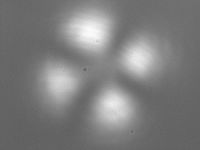Extinction cross

So, imagine we have a flashlight shining at one end of a long hallway. As we move the flashlight closer and closer to the other end of the hall, eventually the light will get so dim that we can't see it anymore. This is kind of like what happens with extinction cross.
Extinction cross is basically when light passes through something and gets blocked, or "extinguished," so that we can't see it anymore. This can happen when a light beam passes through a material that scatters or absorbs light, like some kinds of glass or a foggy day outside.
Scientists use extinction cross to study things like particles in the air or microscopic organisms in water. By measuring how much light gets blocked, they can calculate how many of these tiny things are in the sample. But sometimes, the extinction cross can be so strong that not even special instruments can measure it accurately.
So, to sum it up, extinction cross is when light goes through something and gets blocked so much that we can't see it anymore, and scientists use it to study tiny things in the air or water.
Extinction cross is basically when light passes through something and gets blocked, or "extinguished," so that we can't see it anymore. This can happen when a light beam passes through a material that scatters or absorbs light, like some kinds of glass or a foggy day outside.
Scientists use extinction cross to study things like particles in the air or microscopic organisms in water. By measuring how much light gets blocked, they can calculate how many of these tiny things are in the sample. But sometimes, the extinction cross can be so strong that not even special instruments can measure it accurately.
So, to sum it up, extinction cross is when light goes through something and gets blocked so much that we can't see it anymore, and scientists use it to study tiny things in the air or water.
Related topics others have asked about:
